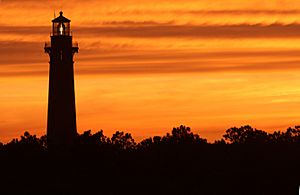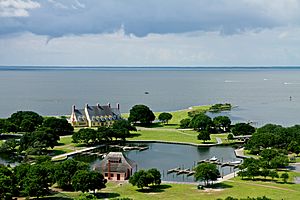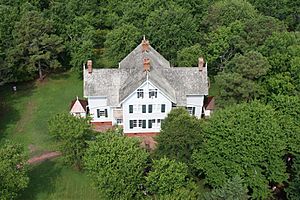Currituck Beach Light facts for kids
| Location | Corolla, North Carolina |
|---|---|
| Coordinates | 36°22′36″N 75°49′51″W / 36.376667°N 75.830833°W |
| Year first lit | 1875 |
| Automated | 1939 |
| Construction | Brick |
| Tower shape | Conical tower |
| Height | 162 ft (49 m) |
| Focal height | 158 feet (48 m) |
| Original lens | First-order Fresnel lens |
| Characteristic | 20-second flash cycle (on for 3 seconds, off for 17 seconds) |
The Currituck Beach Light is a tall lighthouse located on the Outer Banks in Corolla, North Carolina. It's a famous landmark that helps guide ships. This lighthouse was added to the National Register of Historic Places on October 15, 1973, which means it's recognized as an important historical site.
Contents
History of the Currituck Beach Lighthouse
The Currituck Beach Light was finished on December 1, 1875. It was built between two other lighthouses, the Cape Henry Light and the Bodie Island Light. Unlike many other lighthouses, the Currituck Beach Light was never painted. You can still see its original brick walls today!
In 1939, the lighthouse became "automated." This means machines took over the job of turning the light on and off. Before that, lighthouse keepers lived there and did the work by hand. This change happened after the United States Coast Guard took over from the old Bureau of Lighthouses.
Who Takes Care of the Lighthouse?
A group called the Outer Banks Conservationists (OBC) has done a lot of work to fix up and maintain the lighthouse since 1980. They use money from donations and help from volunteers. Since 1991, visitors have been able to climb the 220 steps to the top.
The original lens is still inside and works every night. Because it's still in use, visitors can't go into the lens room. The light shines from 158 feet (48 meters) high, flashing every 20 seconds. It helps warn ships sailing near the barrier islands.
In 2003, the U.S. government officially gave ownership of the lighthouse to OBC. Even though the local county tried to get ownership, OBC won the case in 2006. They continue to own and care for the Currituck Beach Lighthouse.
Amazing Facts About the Lighthouse
Here are some cool facts about the Currituck Beach Lighthouse:
- It has 220 steps to climb to the top.
- The light shines from 158 feet (48 meters) above the ground.
- The very top of the roof is 162 feet (49 meters) high.
- About one million bricks were used to build it.
- The wall at the bottom is 5 feet 8 inches (1.7 meters) thick.
- The wall at the top (the parapet) is 3 feet (0.9 meters) thick.
Why Was This Lighthouse Built?
In the 1870s, many ships were getting lost or damaged along a 40-mile (64 km) stretch of dark coastline. Ships sailing south often stayed closer to shore to avoid the strong Gulf Stream current, which put them in danger. To help, construction on the Currituck Beach Lighthouse began in 1873. It was finished two years later. The date "1873" is carved above the entrance, showing when building started.
How the Light Works
The Currituck Beach Lighthouse is a "first order lighthouse." This means it has the largest type of Fresnel lens, which is a special kind of lens that makes the light very bright and focused.
- Early Days: The first light source used an old lamp fueled by lard oil.
- Later Lamps: Around 1884, it switched to a kerosene lamp. By 1913, it used a lamp that vaporized kerosene for an even brighter light.
Before electricity, a special system was needed to spin the huge lenses. Weights hung from a line, powering a clockwork machine, much like a grandfather clock. The lighthouse keeper had to crank these weights up by hand every two and a half hours!
Automation and Today
Around 1939, the lighthouse became fully automated. The Coast Guard installed computers that turned the light on by themselves. Four 1000-watt light bulbs were put in, but only one flashed at night. The others were backups in case one went out. Because of this, lighthouse keepers were no longer needed.
Today, the Currituck Beach Lighthouse still helps ships navigate. The beacon turns on automatically at dusk and turns off at dawn. With its 20-second flash cycle (3 seconds on, 17 seconds off), the light can be seen for 18 nautical miles (33 kilometers). This unique flash pattern helps sailors know exactly which lighthouse they are seeing. The original four-bulb system has been updated to two long-lasting 1000-watt bulbs.
The Currituck Beach Lighthouse was the last big brick lighthouse built on the Outer Banks.
The Lighthouse Compound
The Outer Banks Conservationists group works hard to restore and keep up the lighthouse and its surrounding buildings. Visitors can climb the lighthouse every day from Easter until Thanksgiving. A small house, which might have been for a third keeper, has been restored and now serves as a museum shop. The outside of the larger Keeper's House has been fixed up, and work continues on the inside. Other buildings on the property include an old two-hole outhouse, two cisterns (tanks that store rainwater), and a storage building used as an office.
Currituck Beach Lighthouse Keepers
These are some of the people who worked as lighthouse keepers at Currituck Beach Light:
- Captain Nathan Swain and Francis Slice Swain (1905–1920)
- Loren Edward Tillett, Sr. (1921–1930)
Amazing Facts About the Lighthouse
Here are some cool facts about the Currituck Beach Light:
- It has 220 steps to climb.
- The light shines from 158 feet (48 meters) above the ground.
- The very top of the roof is 162 feet (49 meters) high.
- About one million bricks were used to build it.
- The wall at the bottom is 5 feet 8 inches (1.7 meters) thick.
- The wall at the top is 3 feet (0.9 meters) thick.
- It is about 34 miles (55 km) south of the Cape Henry Lighthouse in Virginia.
- It is about 32.5 miles (52 km) north-northwest of the Bodie Island Lighthouse.
In 1872, many ships and lives were still being lost along 40 miles (64 km) of dark coastline. This area was not covered by existing lighthouses. Ships sailing closer to shore to avoid the Gulf Stream were in danger. So, construction of the Currituck Beach Lighthouse began in 1873. It was finished two years later. The date "1873" at the entrance shows when building started.
How the Light Works
The Currituck Beach Lighthouse is a first order lighthouse. This means it has the largest type of Fresnel lens. These special lenses help make the light very bright and focused.
At first, the light used a Funck's hydraulic float lamp. This lamp burned lard oil and had four wicks. Around 1884, it switched to a mineral oil (kerosene) lamp with five wicks. By 1913, it used an incandescent oil vapor lamp. This lamp used kerosene vapor forced into the burner by a hand pump.
Before electricity, a special system made the huge lenses spin. Weights hanging from a line powered a clockwork machine. It was like a grandfather clock. The lighthouse keeper had to crank the weights up by hand every two and a half hours.
Around 1939, the lighthouse became fully automated. The Coast Guard took over. Computers were installed to turn the light on automatically. Four 1000-watt bulbs were put in the light room. Only one flashed at night, with the others as backups. Because it was automated, lighthouse keepers were no longer needed.
Today, this lighthouse still helps ships navigate. The light turns on automatically at dusk and off at dawn. It has a 20-second flash cycle: on for 3 seconds, off for 17 seconds. This unique pattern helps sailors know where they are. The light can be seen for 18 nautical miles (33 km). The original four-bulb system has been replaced with two bulbs that last longer.
The Currituck Beach Lighthouse was the last big brick lighthouse built on the Outer Banks.






